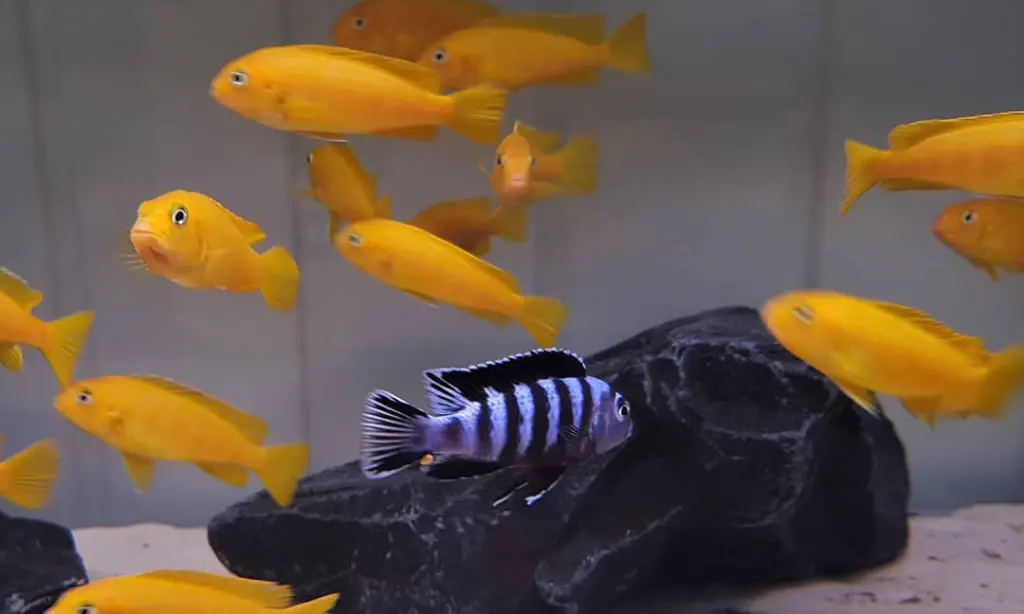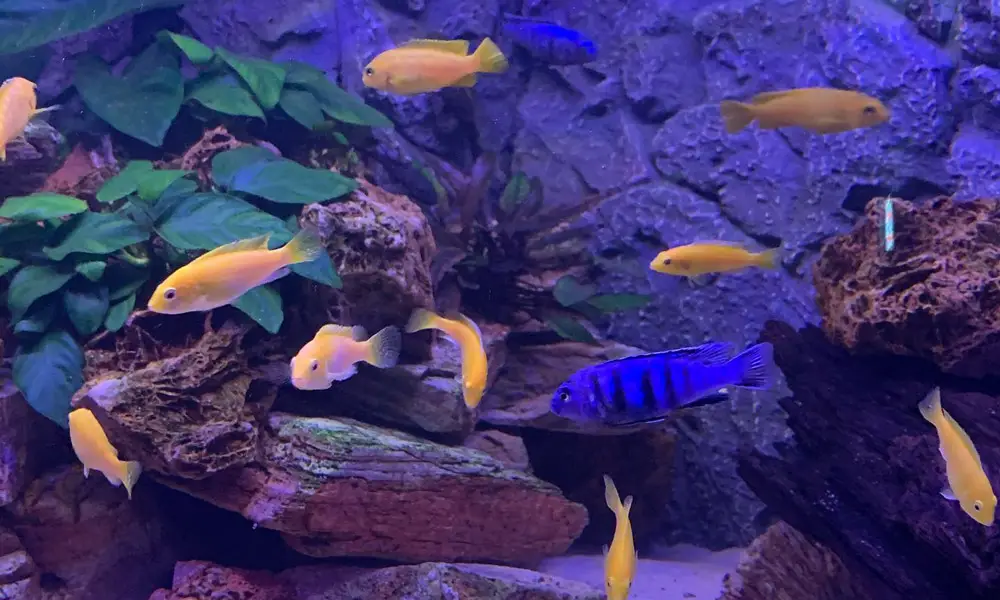The Saulosi Cichlid is a beautiful little mbuna that hails from the rocky, temperate waters of Lake Malawi in southeast Africa. In addition to being aesthetically pleasing, the Saulosi Cichlid is also known for being relatively hardy and easy to care for, making it an ideal choice for beginners and advanced hobbyists alike.
If you’re one of the many aquarists who is thinking of adding these beauties to your aquarium, you need to understand their specific needs. That’s why we’ve put together this guide to Saulosi cichlid care, which will cover the essential information you need to know about Saulosi Cichlid care.
Species Summary
Saulosi Cichlid (Chindongo saulosi), which was previously described as Pseudotropheus Saulosi, hails from the rocky, temperate waters of Lake Malawi in southeast Africa. More specifically found in an area of the Lake called Taiwan Reef.
It is classified as a dwarf-mbuna and was first discovered in 1989 by Ad Konings. These fish are named after Saulos Mwale, a Malawian fisherman who worked at Stuart M Grant Ltd (SMG), the oldest and largest ornamental fish export business in Malawi.
It belongs to the Cichlidae family and is generally easy to care for, making it an ideal choice for aquarists of any skill level.
Chindongo saulosi is listed on the IUCN red list of threatened species as it is only found in Lake Malawi, but thanks to the aquarium trade and dedicated scientists, it has been introduced to many other countries, and its numbers in the wild have not decreased.
Appearance

Mbuna are widely applauded for their stunning appearance and striking colors; the Saulosi Cichlid is no exception.
Fry are born yellow, and they will begin to show adult male or female colors as they reach near adulthood. The dominant male usually has the most vibrant and intense colors. Subdominant males are paler blue, and some younger males can remain mixed in with the females in a typical yellow dress.
Unlike some species of mbuna, sexing Chindongo saulosi is relatively easy. Males are blue with black vertical bars, and females are of deep yellow shade with no spots. Owing to this color difference, one can easily spot males and females without much effort.
The fins and tail are dark, with silver highlights at the end that give a nice contrast. However, don’t confuse them for Pseudotropheus Demasoni (Demanson’s Cichlid) with dark stripes on their heads.
Although tiny, Saulosi cichlids gave an elongated body shape like a torpedo. They boast pharyngeal teeth in their throat, in addition to regular teeth. Also, this fish features one nostril on each side. The fins in both males and females have spiny rays to discourage predators.
Saulosi Cichlid (Chindongo Saulosi) Size
The average size of Saulosi Cichlid is about 3 – 4 inches; that’s why they are categorized as dwarf mbuna. The males are slightly bigger than their female counterparts. However, they cannot be kept in a small aquarium despite their small size.
It is said that they can get a bit longer in the wild, but most fish will max out at this length when kept in captivity.
Lifespan
The average Saulosi Cichlid lifespan is roughly 6 to 10 years in captivity. Proper care and a healthy diet can help these little guys live even longer.
This species is mainly captive-bred. Its genetic makeup plays a major role in its lifespan. Purchasing from reputable sellers can give you access to the hardiest lineages.
Saulosi Cichlid (Chindongo Saulosi) Care
In the wild, these fish can be found at depths of 7-15 meters and prefer roaming the upper part of the reef where the current is stronger.
Like most rock-dwelling cichlids, male Saulosi Cichlids are aggressive and territorial. Therefore, giving males adequate space to prevent territorial disputes from ending fatal is essential.
Saulosi Cichlids fall into the range of relatively hardy fish as these fish can adapt to most aquarium conditions well. They are not fussy and can handle slight fluctuation in their habitat without causing much trouble.
However, providing optimal care is essential. It is advised to replicate their natural habitat as much as possible to make them feel comfortable and contended. Carry out the below-mentioned care guidelines and let this new member enjoy its new home.
Tank Size
Don’t get tempted with the small size while choosing a tank for Chindongo Saulosi. Despite their relatively small size, they shouldn’t be kept in small aquariums.
A recommended tank size of 55 gallons (48″ x 13″ x 21″) is recommended. Such tank dimensions allow Saulosi cichlids to be housed in groups. Some fish owners say you can keep them with tanks as small as 20 gallons, but we disagree.
These fish do best in groups. In the lake, females will school together in very large groups of at least 50 individuals or more.
You might be interested to know more: cookie cutter setups in a 55 gallon fish tank.
Water Parameter
Saulosis are very forgiving fish that can tolerate a wide range of water parameters, but to ensure the long and healthy life of your Saulosi, you should always try to maintain optimal water conditions.
They’re native to the Rift Lake Malawi, where the water is alkaline. This cichlid has some salt tolerance but can’t survive in a full brackish water environment. Use the following parameters as a guideline for Saulosi cichlid care:
- Water Temperature: 73 – 82°F
- pH: 7.5 – 8.4
- Hardness: 7 – 30 dGH
- Specific Gravity: < 1.0002
- Ammonia: 0ppm
- Nitrite: 0ppm
- Nitrate: <10ppm
Once the ideal water condition is attained, it is essential to maintain it as sudden fluctuation can harm the fish. Malawi Cichlids are especially susceptible to Malawi Bloat due to the poor water conditions; even many aquarists believe the bloat is mainly caused by their dietary needs.
It’s important to test the water conditions regularly and do a 10-20% water change weekly, depending on the bio load. We suggest investing in an accurate testing kit and a protein skimmer to ensure good water quality.
[amazon box=”B000255NCI”]Decor
Sand is the most commonly preferred substrate for Chindongo Saulosi. But, fishkeepers can also use crushed coral or Aragonite as substrate, which helps maintain the water’s pH level. Since these substrates are available in light shades, you can wrap them in a mesh sack and place them in the filtration system around the outflow.
While a dark substrate, such as black diamond blasting sand, can make your Saulosi’s coloration more pronounced and feel safe, it isn’t necessary. It all comes down to your personal preference.
The natural habitat of Saulosi Cichlid is a sediment-free area and deep rocky structures. So, it’s recommended to add plenty of rocky structures to the tank.
Do not forget to create crevices when placing these decors so fish can pass to emulate their home in the wild.
Typically, live aquarium plants don’t do well with Lake Malawi Cichlids, but they can still be included in Saulosi Cichlid’s tank. Certain plants, such as Anubias and Amazon swords, thrive well in hard water with higher amounts of minerals.
Food & Diet
Saulosi Cichlid is omnivorous and loves eating tough, stingy algae attached to the rocks as they often contain snails, nymphs, crustaceans, insect larvae, and mites. Since these fish has a big appetite, fishkeepers should raise them on an herbivore diet.
The diet should be primarily spirulina and spinach and treat them with protein-rich food occasionally. Various forms of vegetables such as cucumber, blanched romaine lettuce, and spinach is good choices.
Some foods you should avoid while feeding Saulosi Cichlid are live fish, mammalian meat, worms, and pellets of any type.
Saulosi cichlid (Chindongo saulosi) Tank Mates

Don’t go by the size as Pseudotropheus Saulosi are more aggressive. Males are highly territorial and competitive, while females are friendly and calm.
Since Saulosi Cichlids are moderately aggressive, hobbyists must choose tank mates according to their behavior and temperament.
These fish are best kept in large groups. One dominant male with several females provides a happy and peaceful environment. Owning just one male and female will result in fighting over territory and lead to death.
If you choose to keep multiple males, be sure to provide plenty of hiding spots and cover so they can establish their own territories.
You shouldn’t have any major problems when you keep them with other similar-sized mbuna but avoid species with a similar color pattern. Labidochromis species are the best choice.
Breeding
The Saulosi cichlid is a maternal mouthbrooder. When ready to spawn, the male will show intense coloration and become more aggressive. Meanwhile, he will select and clean a spawning site and then display the females until there is one to accept him.
The male will attempt to lead the matched female to his site by shaking his tail in a head-to-tail manner that is only seen during spawning. He will repeat the process a number of times until the female lays eggs.
After laying 10 to 20 eggs, depending on the size of the female, she will immediately pick them up to her mouth. At the same time, the male display by shaking his anal fin and releasing sperm. The female mistaken the “egg spots” as her eggs and collects them in her mouth, which then fertilizes the real eggs in her mouth.
This process will take hours. Once the female lays eggs, she will hold them in her mouth for 13- 18 days until they hatch. The fry are free-swimming after another 7 to 10 days.
The fry can be fed with baby brine shrimp and rotifers. You should feed them small amounts frequently, and twice a day is best. Provide plenty of hiding places, so the fry can hide and grow until they are too big to eat.
Breeding Saulosi Cichlids can be challenging, but with patience and careful observation, you will surely succeed.
Final Thought
That’s it, folks. We have jotted down everything in this comprehensive Saulosi Cichlid care guide to help you make the right decision. Don’t get tempted by their small stature, and remember that they are mbunas, notorious for their anger. Hence, keep them in the overcrowded tank and go for these fishes only if you have some experience with raising aggressive fishes.
If you have any questions or suggestions, please feel free to share them in the comment section below. Also, don’t forget to share this care guide with fellow fishkeepers.
